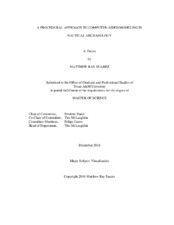| dc.description.abstract | This research is to determine the functionality and applicability of procedural computer-based modeling techniques in the field of nautical archaeology. To demonstrate this approach, an interactive procedural model of the lower hull timbers of a 16th century European merchant ship was developed through an iterative process of prototype implementation. Evaluation of the usefulness and effectiveness of the prototypes based on their potential research applications was conducted by Dr. Filipe Castro of the Texas A&M Department of Anthropology.
The 3D model was created using Houdini, a procedural node-based 3D software package. First, a basic collection of main timber components that go into the construction of a ship’s hull was determined. Functional rules were created for each timber based on real-world ship design and construction processes. These rules were incorporated into the logic of the procedural modeling algorithm. I built into this model the ability of varying specific dimensions of each component, while adhering to the rules of the algorithm. Each component was updated, in real-time, as revisions were made to interdependent components.
The resulting procedural approach created a flexible and interactive model which can be iterated with parametric control, thus reducing revision time. The results of this project provide evidence of the time-saving effectiveness of a procedural approach to creating 3D models as a research tool. This is useful because once procedural models are created, they provide an accessible means for researchers to create multiple interpretations. Based on my experience with this project, I believe that the flexibility provided by procedural modeling provides an overall time efficient solution for 3D modeling in nautical archaeology. The construction of a procedural model requires a significant investment in design, construction, and trouble-shooting; however, this is out-weighed by the flexibility it offers. | en |


